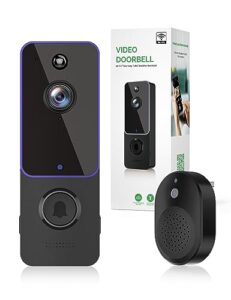How To Install A Smart Doorbell?
Key Takeaways
- Installing a smart doorbell can enhance the security and convenience of your home.
- The installation process includes pre-installation preparation, choosing the ideal location, and mounting the smart doorbell.
- Additional steps include wiring for wired doorbells, connecting to power and Wi-Fi, adjusting settings and testing, and optionally installing a doorbell chime.
Installing a smart doorbell can enhance the security and convenience of your home. With the ability to see and communicate with visitors from anywhere using your smartphone, a smart doorbell is a valuable addition to any modern home. In this article, we will provide a step-by-step guide on how to install a smart doorbell, covering both battery-powered and wired options. Whether you are a DIY enthusiast or a novice, these instructions will help you successfully set up your smart doorbell.
Step 1: Pre-Installation Preparation
The first step in installing a smart doorbell is to ensure you have everything you need. Download the corresponding app for your doorbell and create an account. This app will be essential for managing your doorbell’s settings and receiving notifications. Make sure to also charge the battery if you have a battery-powered doorbell.
Step 2: Choose the Ideal Location
Before mounting your smart doorbell, carefully choose the location. Ideally, it should be near your existing doorbell’s location. This will make the installation process easier, especially if you have a wired doorbell. Additionally, consider factors such as visibility, Wi-Fi signal strength, and accessibility for visitors.
Step 3: Mounting Your Smart Doorbell
If you have a battery-powered doorbell, you can proceed with mounting it. Attach the mounting plate to the wall or front door using the provided screws. Ensure that the plate is securely attached and level.
For wired doorbells, you will need to turn off the power to your existing doorbell at the breaker box before proceeding. Check the compatibility of your existing transformer, as it may need to be replaced if it doesn’t meet the requirements of your new smart doorbell.
Step 4: Wiring for Wired Doorbells
If you have a wired doorbell, you will need to follow the manufacturer’s instructions for wiring the doorbell and removing the old one. This step requires some knowledge of domestic wiring, so if you’re unsure, consider hiring a professional.
Once the wiring is complete, install the new doorbell by marking out screw locations, drilling holes, inserting wall anchors, and attaching the wires. Ensure that the doorbell is securely mounted and level.
Step 5: Connecting to Power and Wi-Fi
After the physical installation, you can proceed with connecting your smart doorbell to power and Wi-Fi. Turn on the power to your doorbell at the breaker box for wired doorbells. For battery-powered doorbells, ensure that the battery is fully charged.
Using the app, connect the doorbell to your home Wi-Fi network. Follow the instructions provided by the manufacturer to complete the setup process. This may involve scanning a QR code, entering a verification code, or other similar steps.
Step 6: Adjusting Settings and Testing
Once your smart doorbell is connected to Wi-Fi, you can customize its settings through the app. This includes adjusting motion detection sensitivity, setting up notifications, and enabling additional features such as two-way audio or video recording.
After adjusting the settings, it’s important to test your smart doorbell. Have a friend or family member ring the doorbell and ensure that you receive a notification on your smartphone or tablet. Test the video and audio quality to ensure everything is working as expected.
Optional: Installing a Doorbell Chime
If you prefer to have a physical chime inside your home to accompany the smart doorbell notifications, you can install a compatible doorbell chime. Follow the manufacturer’s instructions for wiring and installing the chime, and sync it with your smart doorbell through the app.
It’s important to note that the installation process may vary slightly depending on the brand and model of your smart doorbell. Always refer to the specific instructions provided by the manufacturer.
Conclusion
Installing a smart doorbell is a relatively straightforward process that can be done by most DIY enthusiasts. By following these step-by-step instructions, you can successfully install a smart doorbell, whether it is battery-powered or wired. Remember to prioritize safety by turning off the power for wired doorbells and seeking professional help if you are unsure about any electrical wiring.
Related Websites:
FAQs:
Q: What are the benefits of a smart doorbell?
Smart doorbells provide convenience and enhanced security. They allow you to see and speak to visitors remotely through a smartphone app, receive instant notifications when someone is at your door, and record video footage of any activity outside your home.
Q: How do smart doorbells work?
Smart doorbells use Wi-Fi to connect to your home network. When someone presses the doorbell button or triggers its motion sensors, it sends a notification to your smartphone. You can then see a live video feed, communicate with the visitor through two-way audio, and even unlock the door remotely if integrated with a compatible smart lock.
Q: What types of smart doorbells are available in the market?
There are various types of smart doorbells available, ranging from battery-powered models to ones that require existing doorbell wiring for power. Some have advanced features like facial recognition, infrared night vision, or even built-in storage for video recordings. You can choose the one that suits your needs and preferences.
Q: What are the required tools and materials for installing a smart doorbell?
The tools and materials needed for installation may vary depending on the specific model and your existing doorbell system. However, common requirements include a screwdriver, wire strippers, electrical tape, mounting screws, and a power drill (if necessary). It’s always recommended to refer to the manufacturer’s instructions for the exact requirements.
Q: What are some common troubleshooting steps for smart doorbell installation issues?
If you encounter issues during installation, some common troubleshooting steps include checking your Wi-Fi signal strength, ensuring proper wiring connections, and ensuring the doorbell is within the recommended operating temperature range. If problems persist, referring to the manufacturer’s support documentation or contacting customer support can provide further assistance.






